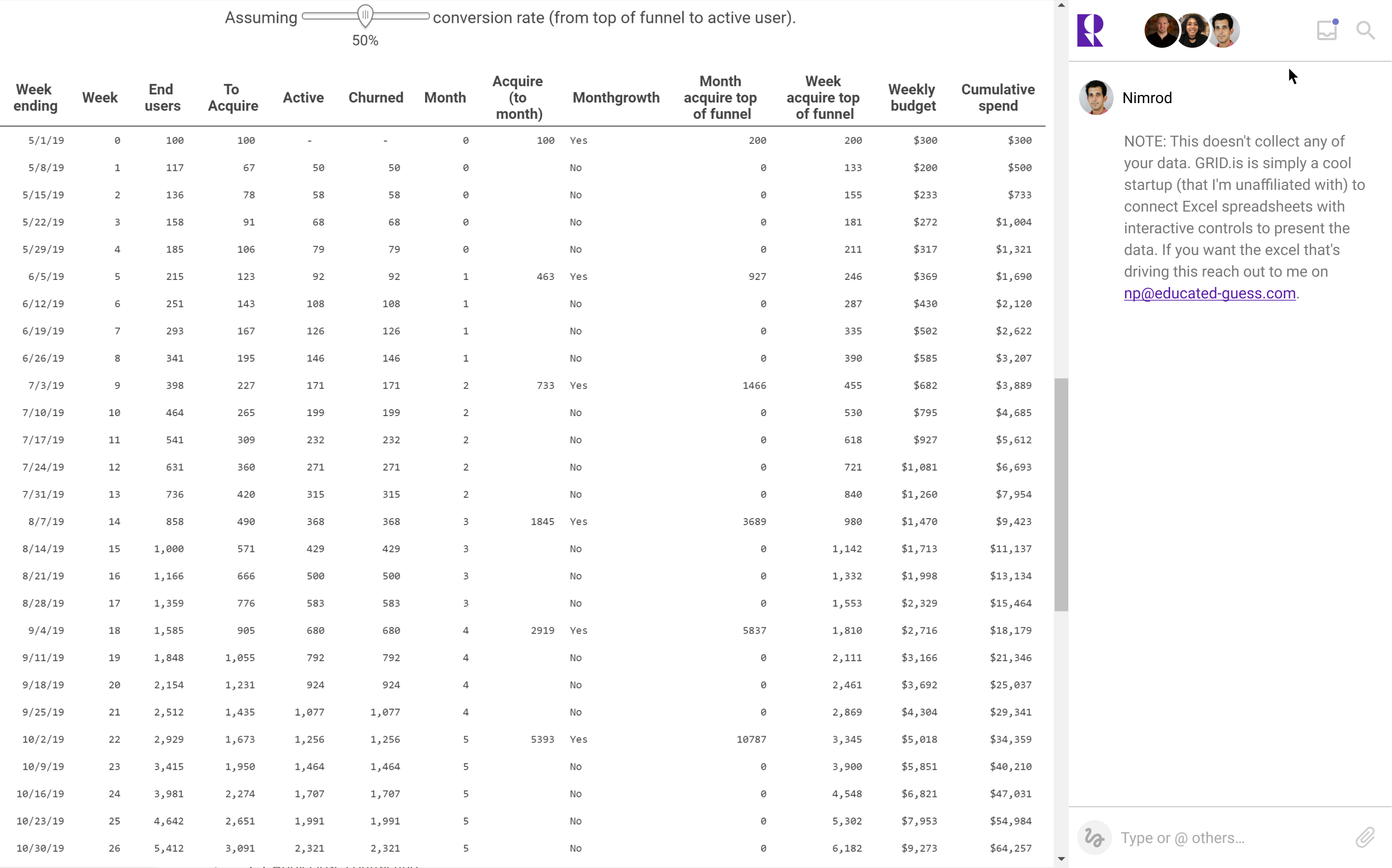css跑道
There’s lots of startup advice floating around. I’m going to give you a very practical one that’s often missed — how to plan your early growth. The seed round is usually devoted to finding your product-market fit, meaning you start with no or little product and should end with a demonstrably retentive and growing population of users. It’s this growth stretch that I’ll tell you how to plan — and once you do that, you’ll have a clear timeline for your seed:
周圍有很多啟動建議。 我將為您提供一個經常被人錯過的非常實用的方法-如何計劃您的早期成長。 種子輪通常致力于找到適合您的產品市場的產品,這意味著您一開始就沒有產品或只有很少的產品,并且應該以明顯的保持性和不斷增長的用戶群體結束。 我將告訴您如何規劃增長—一旦這樣做,您將為種子設定明確的時間表 :
While there are differences, Series A is broadly raised when you have early traction, evaluated through growth rates and ARR or potentially-monetizable userbase.
盡管存在差異,但您可以通過增長速度 , ARR或潛在可獲利的用戶群進行評估,從而廣泛提高A系列的價值。
- What’s a good userbase? One that could or is generating about $1M ARR. 什么是好的用戶群? 一個可能或正在產生約100萬美元的ARR。
- Why $1M ARR? Because your series A will be in the vicinity of $10M valuation, and x10 is generally the multiple used at this stage. There are many variations, but rarely order-of-magnitude ones. 為什么要有100萬美元的ARR? 因為您的A系列估值將在1000萬美元附近,所以x10通常是此階段使用的倍數。 有很多變化,但數量級很少。
What’s a good growth rate? Paul Graham says 5%-7% w/w and David Sacks says 15%-20% per month (which is slightly slower). You can easily find 100 other benchmarks for the numbers above on Twitter and VC blogs/podcasts — but unless you’re going into investment, there’s no use spending so much time on that, just use these numbers as a guide and then do your best.
好的增長率是多少? 保羅·格雷厄姆( Paul Graham) 表示,重量百分比為5%-7% ,大衛·薩克斯( David Sacks )則為每月15%-20% (稍慢)。 您可以在Twitter和VC博客/播客上輕松找到上述數字的其他100個基準-但是,除非您要進行投資,否則花太多時間在上面是沒有用的,只需將這些數字用作指導,然后盡力而為。
Taken together, all these numbers mean this is how your seed growth plan should look like: You raised enough capital for X months, say 18. Just before that money runs out you better start raising your Series A with traction at around $1M ARR. Maybe you’d like a 3-month buffer to raise and in case you miss your growth goals. With a growth rate of 5% w/w, how long does it take to make $1M ARR? Should you start at month 12 after your Seed? Or month 3? How long does that leave you to reach PMF? What if you missed the start of growth by a few months, how fast do you need to grow now to catch up? How many users does that mean you need to bring every week? This simple interactive model will answer all of these questions. (this is on grid.is which makes spreadsheets interactive. I am unaffiliated with them, I just like the tool).
綜上所述,所有這些數字都意味著您的種子成長計劃應該是這樣的:您籌集了足夠的資金用于X個月,例如18。 也許您希望增加3個月的緩沖時間,以防您錯過增長目標。 如果增長率為5%w / w,則需要多長時間才能實現100萬美元的ARR? 您應該在種子發布后的第12個月開始嗎? 還是第3個月? 那要等多久才能達到PMF? 如果您錯過了幾個月的增長起點,您現在需要多快才能趕上增長呢? 這意味著您每周需要帶多少用戶? 這個簡單的交互式模型將回答所有這些問題。 (這是在grid.is上,它使電子表格具有交互性。我不喜歡它們,就像工具一樣)。

To use it, you fill in your target end date (3 months before you run out of cash, so you need to raise your next round). Put in a starting amount of users you will get from your first blast/launch (perhaps users in your waiting list or a major first push — like 100 or so). Then, set your goal number of users, and what your predicted weekly churn rate is. Only then, start playing with the ‘Start on field’. What happens if you give yourself 4 months to grow? Is that a realistic growth rate or will you need to hit rarely seen >10% w/w growth? How about 10 months? Do you have 10+3 months left your runway or should you start growth against weekly goals today?
要使用它,請填寫您的目標結束日期(現金用盡前3個月,因此您需要提高下一輪)。 錄入您將從第一次爆炸/啟動中獲得的起始用戶數量(也許在您的等待列表中或主要的首次推送中的用戶-例如100左右)。 然后,設置您的目標用戶數以及預計的每周用戶流失率。 只有這樣,才能開始使用“開始比賽”。 如果您給自己四個月的成長時間會怎樣? 這是一個現實的增長率,還是您需要實現罕見的> 10%w / w的增長率? 10個月怎么樣? 您是否還有10 + 3個月的時間要走,還是今天應該按照每周目標開始增長?
You can find a table that gives you the exact week-by-week goals for growth that you can just print and share with your team. You can put in how much did you actually realize every week and are you ahead or behind goal. Focusing just on this, as Paul Graham says, will guide you to success or to a better idea for your startup.
您可以找到一張表格,該表格可以為您提供每周確切的增長目標,您可以打印并與團隊共享。 您可以輸入您實際上每周實際實現了多少,以及您在目標之前還是之后。 正如Paul Graham所說的那樣,專注于此將指導您成功或為您的創業提供更好的主意。
Focusing on hitting a growth rate reduces the otherwise bewilderingly multifarious problem of starting a startup to a single problem. — P. Graham
專注于達到增長速度,將原本令人難以置信的繁雜問題從啟動初創企業簡化為單個問題。 — P. Graham

This model is the basic one, and you can go fancy and add more options — splitting out by organic and paid growth, by channel, or adding in varying revenue; You can easily model some low and capped virality (e.g, every person might lead to up to 3 more people with 15% probability). Feel free to reach out to me for the Excel to build these over, and I’d especially love to learn if this changed something about how you planned your seed round. The screenshots above are from the interactive model.
該模型是基本模型,您可以看中并添加更多選項-按自然增長和有償增長,按渠道劃分或增加收入; 您可以輕松地模擬一些低強度的病毒(例如,每個人可能以15%的概率導致多至3個人)。 請隨時與我聯系以使用Excel構建這些副本,我尤其想了解這是否改變了您計劃種子輪的方式。 上面的屏幕截圖來自交互式模型 。
翻譯自: https://towardsdatascience.com/how-to-not-run-out-of-runway-the-simple-way-to-plan-your-seed-ef2f2c79548
css跑道
本文來自互聯網用戶投稿,該文觀點僅代表作者本人,不代表本站立場。本站僅提供信息存儲空間服務,不擁有所有權,不承擔相關法律責任。 如若轉載,請注明出處:http://www.pswp.cn/news/391542.shtml 繁體地址,請注明出處:http://hk.pswp.cn/news/391542.shtml 英文地址,請注明出處:http://en.pswp.cn/news/391542.shtml
如若內容造成侵權/違法違規/事實不符,請聯系多彩編程網進行投訴反饋email:809451989@qq.com,一經查實,立即刪除!


)




)





)



)
